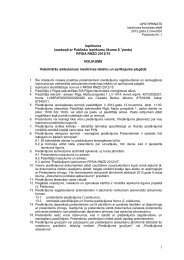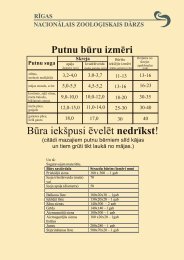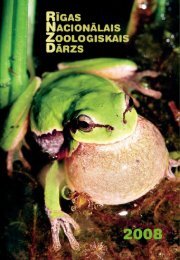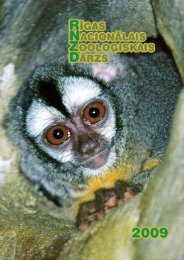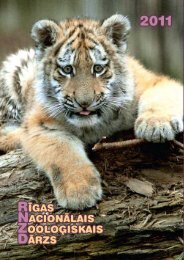You also want an ePaper? Increase the reach of your titles
YUMPU automatically turns print PDFs into web optimized ePapers that Google loves.
BEZMUGURKAULNIEKI<br />
SAUSZEMES BEZMUGURKAULNIEKI<br />
Insektârija kolekcijâ ir daþâdi sauszemes posmkâji,<br />
to skaitâ skorpioni, putnuzirnekïi, zarkukaiòi, vaboles,<br />
tûkstoðkâji u.c. 2007. gadâ ekspozîcijâ veiksmîgi<br />
atjaunojâm divas iepriekðçjos gados zaudçtas sugas.<br />
Ðogad arî pârskatîjâm kolekciju un atteicâmies no<br />
daþâm mazâk interesantâm sugâm, bet 2008. gadâ<br />
plânojam kolekciju papildinât ar vairâkâm jaunâm.<br />
Jûnijâ mûsu kolekcijâ atgriezâs lapgrieþskudras<br />
Atta cephalotes. Pirms tam pârtraukumu darbâ<br />
izmantojâm formikârija uzlaboðanai, atrisinot tâ<br />
ekspluatâcijas gaitâ raduðâs problçmas.<br />
Atsâkâm eksponçt arî alu circeòus Phaeophilacris<br />
bredoides, jo 2006. gadâ no Amsterdamas kolçìiem<br />
saòemtâ jaunâ populâcija ïoti labi savairojâs.<br />
2006. gadâ no kolçìiem Nîderlandç un Anglijâ<br />
saòçmâm milzu zarkukaiòu Phobaeticus serratipes<br />
olas no divâm daþâdâm populâcijâm. Tâpat kâ notika<br />
mûsu lîdzðinçjâ populâcijâ un daudzâs citâs<br />
kolekcijâs, arî no ðîm olâm izðíîlâs tikai mâtîtes, kas<br />
turpmâk normâli dzîvo un vairojas partenoìençtiski -<br />
izveidojas stabila partenoìençtiska populâcija. Tâ<br />
mums neizdevâs atjaunot pilnvçrtîgu populâciju, kurâ<br />
bûtu arî tçviòi, tomçr ðo zarkukaiòu milzîgâs mâtîtes<br />
visu gadu lieliski "kalpoja” Tropu mâjas ekspozîcijâ.<br />
Turpinâm piedalîties Fregates diþmelnuïu<br />
Polposipus herculeanus EEP. Regulçjot kâpuru<br />
daudzumu, 2007. gadâ uzturçjâm ap 130 vaboïu lielu<br />
populâciju. Pirmâs paaudzes vaboles paðlaik râdâm<br />
ekspozîcijâ Tropu mâjâ, bet otrâs un treðâs paaudzes<br />
vaboles vairojas Insektârija telpâs, un drîz gaidâm<br />
Ilona Roma<br />
Insektârija vadîtâja (sauszemes bezmugurkaulnieki)<br />
Diâna Tîfenberga<br />
Akvârija zoologs (ûdens bezmugurkaulnieki)<br />
Bezmugurkaulnieku kolekcija 2007. gadâ:<br />
58 sugas gada beigâs<br />
Vairojâs 41 suga<br />
Platymeris sp. 'Mombo' - jauna laupîtâjblakðu suga kolekcijâ. Kreisajâ pusç -<br />
jauns, labajâ - pieaudzis kukainis.<br />
Platymeris sp. 'Mombo' - a new assassin bug species in our collection.<br />
Left: larva, right: adult beetle.<br />
Foto: Elîna Gulbe<br />
INVERTEBRATES<br />
At the end of 2007, there are 58 species in Riga Zoo invertebrate collection. 41 species bred in 2007.<br />
In 2007 two species were reestablished in the exhibit at Tropical House. A new colony of Leaf-cutter ants Atta cephalotes arrived in June.<br />
Prior to this, we improved the formicarium and solved the problems that were arisen during the work with the previous A. cephalotes colony.<br />
The second species renewed in exhibit was African cave cricket Phoephidacris bredoides, as the population received from Amsterdam<br />
colleagues in 2006 bred well.<br />
In 2006 we received stick insect Phobaeticus serratipes eggs from two different collections in the Netherlands and UK. Unfortunately we<br />
failed to establish a bisexual population (only females hatched from the eggs), but the gigantic stick insect females served well at the exhibit<br />
in Tropical House.<br />
We continue to maintain the populations of EEP species. Amphibian Department continues to work with Partula snails ( Partula radiolata,<br />
P. tristis and P. varia), and Insectarium continues to work with critically endangered Fregate Island palm beetle Polposipus herculeanus. This<br />
year we did not breed the species intensively, but controlled the number of larvae, maintaining ca. 130 beetles in the population.<br />
In 2007 we received a new assassin bug species, Platymeris sp. 'Mombo' from colleagues from Latgale Zoo, Latvia. This species is<br />
closely related to the other assassin bug species in our collection, P. biguttata, and we plan to exhibit both species in one terrarium.<br />
The experiments with various substrate composition for our flower beetles continued. Following the advice of French colleagues, now we<br />
use a new method of fermentation, as well as add llama faeces to the substrate.<br />
In 2007 we started a new project. We would like to exhibit the Latvian ants to the visitors. Three colonies of Lasius niger (Black ants) were<br />
formed. Currently we are trying to establish a formicarium design for safe keeping of ants. An exhibit of 2-3 native ant colonies would be of<br />
interest for zoo visitors.<br />
Insectarium Department reduced the food insect production this year, stopping the breeding of some insect species readily available from<br />
suppliers ( Gryllus assimilis, Tenebrio molitor). Also, the breeding of fruit flies was taken up by Amphibian Department. We continue to breed<br />
locusts Locusta migratoria and several cockroach species ( Gromphadorrhina portentosa, Shelfordella tartara, Blaptica dubia) in Insect<br />
Quarantine facilities in the Old Elephant House. Insectarium supplied other zoo animal departments with 182.5 kg of live food insects in 2007.<br />
This year we had to move a part of our premises to other facilities. The sanitary and disinfection measures allowed to free our insect<br />
cultures of several pests. At last our collection is free from Phorid flies ( Megaselia scalaris) that previously affected our food insect cultures.<br />
Aquarium Department maintains the exhibit of Marine Aquarium with several soft coral and sea anemone species. Our sea invertebrates<br />
benefited much from installing of an artificial wave system. That improved both their growth and reproduction. During 2007, several new<br />
polyps developed, including those of Litophyton, Discosoma, and Zoanthus.<br />
21



